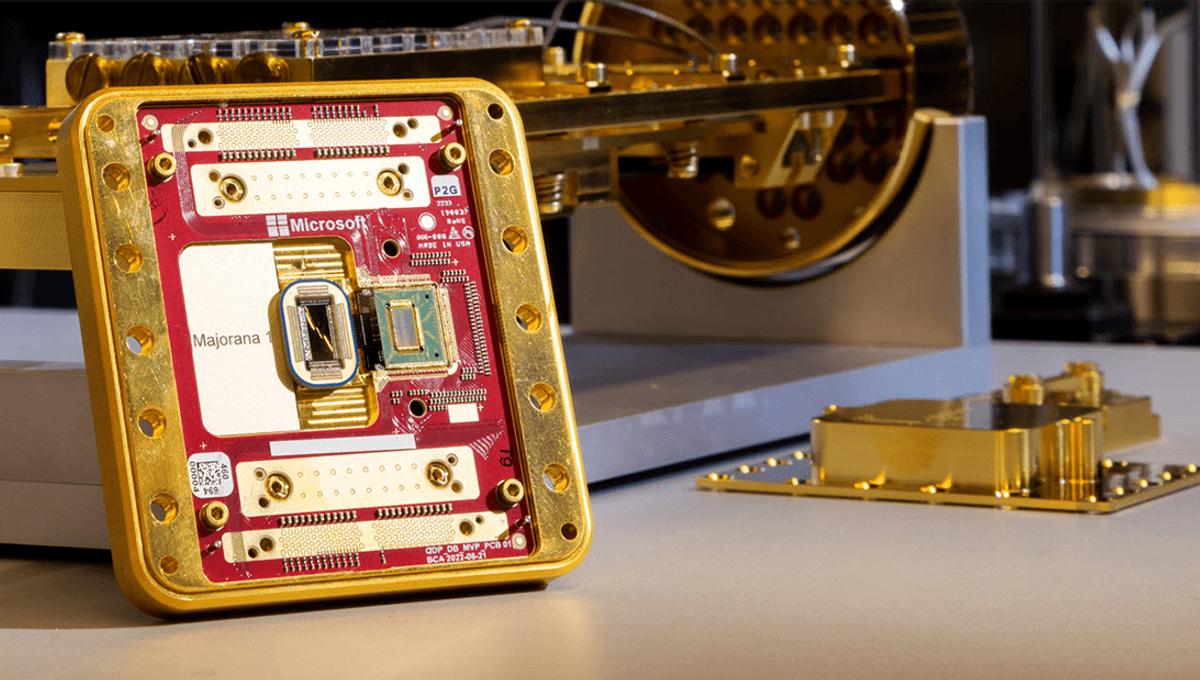
Microsoft has unveiled a new quantum chip named Majorana 1 which it claims will be able to solve major, real-world problems within decades. Though others are skeptical of the claims, Microsoft adds that their new chip design involves manipulating an “entirely new state of matter”.
ADVERTISEMENT GO AD FREE
Quantum computing, like nuclear fusion power, is always claimed to be a few decades away. One of the many problems the field needs to address if quantum computers are to become useful is the number of errors they produce, a result of qubits being particularly sensitive to environmental disturbances such as material defects, or being heated to slightly higher than near absolute zero. On the quantum level, things get a little messy.
Microsoft hopes to get around some of these problems by creating “topological qubits”, manipulating a new state of matter.
“Our team at Microsoft has been able to take a subatomic particle that has only been theorized until now, and not only observe it, but control it,” Krysta Svore, Microsoft technical fellow, said in an accompanying video.
You are likely well aware of the usual states of matter; solid, liquid, and gas, each coming with their own properties defined by the behavior of their component atoms. But there are others out there too.
“A hundred years ago, mathematicians predicted one such new state of matter: the topological state. And since then, researchers have been looking for a very specific, very useful quasi-particle within it, the Majorana particle,” Svore said. “Last year, we were able to observe it for the first time. And this year, we’re able to control it and use its unique properties to build a topoconductor, a new type of semiconductor that operates also as a superconductor.”
ADVERTISEMENT GO AD FREE
One of the useful properties of the Majorana quasiparticle is that it is its own antiparticle.
“Majorana’s theory showed that mathematically it’s possible to have a particle that is its own antiparticle,” Matthias Troyer, Microsoft technical fellow, added. “That means you can take two of these particles and you bring them together, and they could annihilate and there’s nothing left. Or you could take two particles and bring them together and you just have two particles. Sometimes it’s nothing, the zero state; and sometimes it’s the electron, the one state.”
The device uses a superconducting nanowire device made of indium arsenide to connect two topoconducting wires into an H shape, before manipulating Majorana quasiparticles into existence at the ends of the H shape using magnetic fields and superconductors.
In materials that exhibit superconducting properties at very low temperatures, two electrons get together and form Cooper pairs. Any unpaired electron added to the system enters an excited state, and the difference in energy between the two states can function as ones and zeros in computing.
ADVERTISEMENT GO AD FREE
In the Majorana 1 chip, Microsoft says that the electron is shared between two Majorana quasiparticles in a delocalized state. Using careful measurements performed using microwaves, they say they are able to tell the difference between one billion and one billion and one electrons in a superconducting wire, telling the computer what state the qubits are in. Microsoft explains that this is much more resistant to errors than other quantum computers.
“We took a step back and said ‘OK, let’s invent the transistor for the quantum age. What properties does it need to have?’” Chetan Nayak, Microsoft technical fellow, said in a statement. “And that’s really how we got here – it’s the particular combination, the quality and the important details in our new materials stack that have enabled a new kind of qubit and ultimately our entire architecture.”
While exciting, some are skeptical about the results. While Microsoft has published intermediate results, by their own admission in the paper they “do not, by themselves, determine whether the low-energy states detected by interferometry are topological”. Further tests, alluded to in the press release, are more confident, but these have not been published yet. While Microsoft appears confident in its results, previous studies that claimed Majorana states have been retracted in the past.
ADVERTISEMENT GO AD FREE
“As we perform more types of measurements, it will become harder to explain our results with non-topological models,” Nayak told Nature. “There may not be one single moment when everyone will be convinced. But non-topological explanations will require more and more fine-tuning.”
The next problem, once it is confirmed that what they think is going on is actually going on, is to scale it up. At the moment, they have made a chip with eight topological qubits, and they are aiming for one million. Nevertheless, they say that with these chips the next generation of quantum computers could be doing useful, reliable work within years, rather than decades.
The paper is published in the journal Nature.
Source Link: Microsoft Says Its Majorana 1 Quantum Chip Uses Entirely New State Of Matter To Work